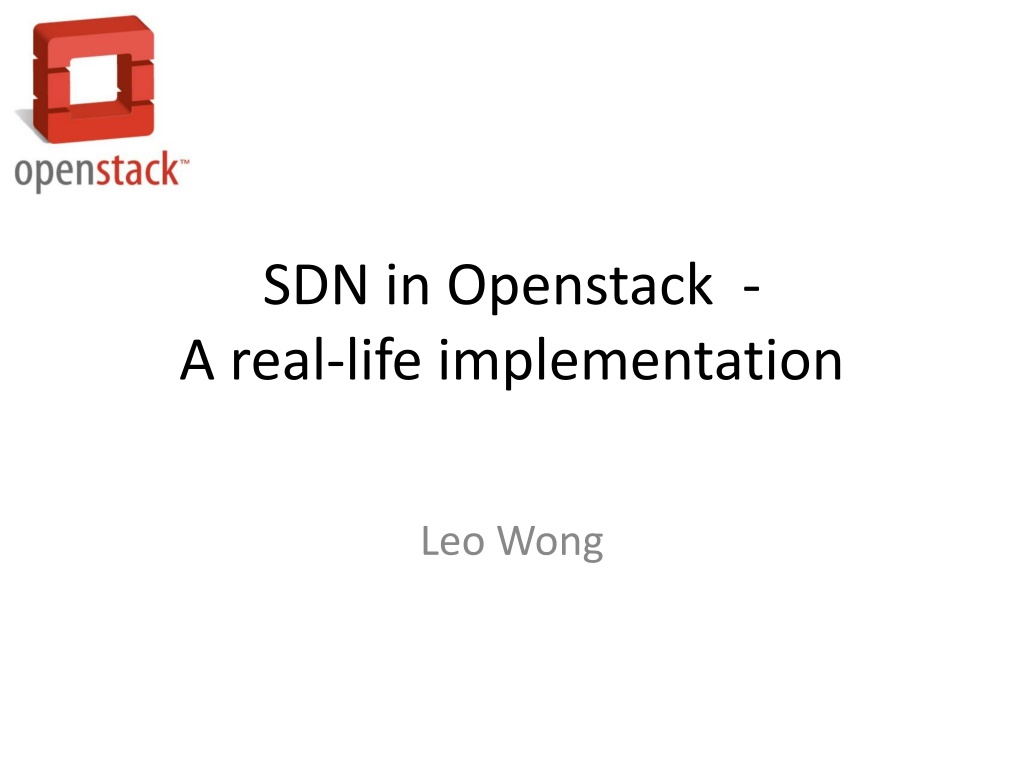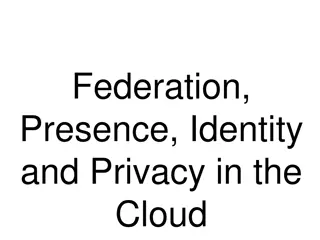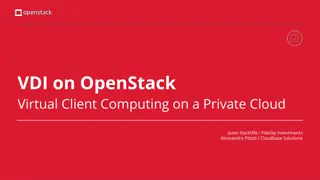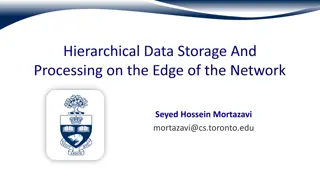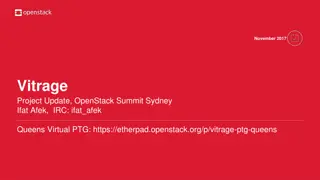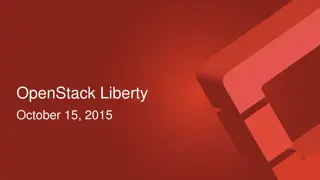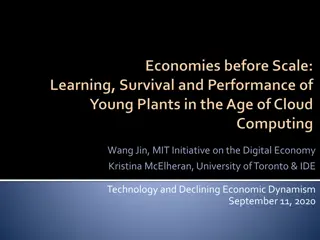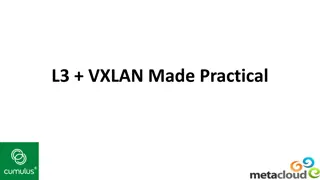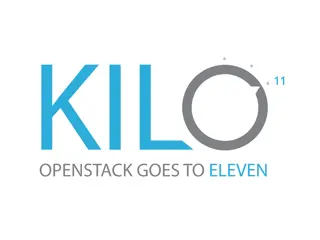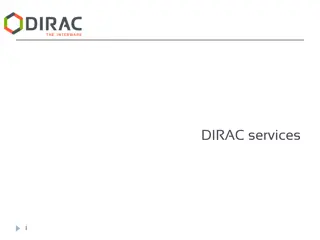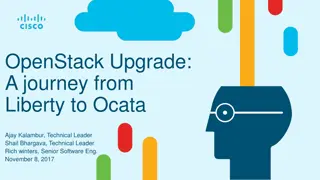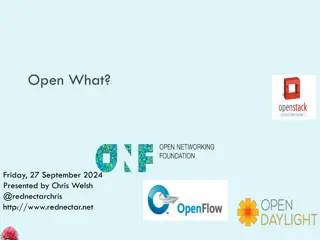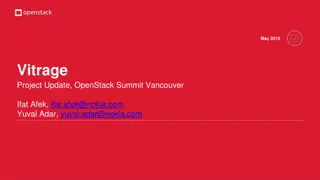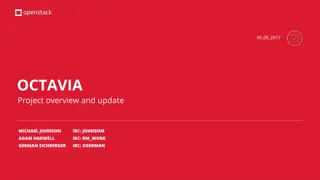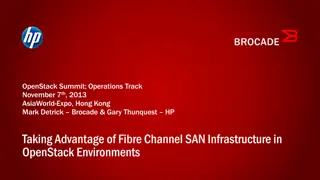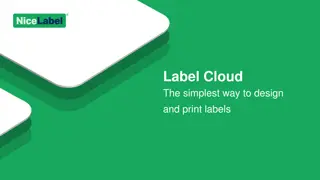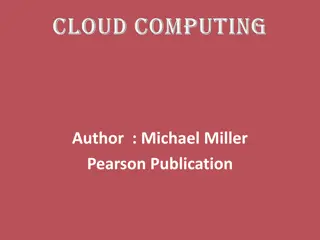Understanding SDN and OpenStack in Cloud Computing
SDN in OpenStack enables innovation, accelerates new features and services, and simplifies provisioning. OpenStack is an open-source cloud software collection with tenant-facing APIs for consuming cloud services. OpenStack services include Compute, Block Storage, Object Storage, Images, and Network capabilities. Challenges like technology limitations and lack of tenant control in the cloud are addressed through SDN and OpenStack solutions. Quantum basics provide an overview of key API abstractions for Compute and Network services in OpenStack.
Download Presentation

Please find below an Image/Link to download the presentation.
The content on the website is provided AS IS for your information and personal use only. It may not be sold, licensed, or shared on other websites without obtaining consent from the author. Download presentation by click this link. If you encounter any issues during the download, it is possible that the publisher has removed the file from their server.
E N D
Presentation Transcript
SDN in Openstack - A real-life implementation Leo Wong
What is SDN Enable innovation / differentiation Accelerate new features and services introduction Programmability Application Layer API Simplify Provisioning Optimize performance Granular policy management Centralized Intelligence Control Layer API Decouple HW / SW, Control Plane and Forwarding, Physical and Logical Config Abstraction Infrastructure Layer Reference: ONF, Dan Pitt
What is OpenStack? Open Source Cloud Software A collection of cloud services Each service includes: A tenant-facing API that exposes logical abstractions for consuming the service. One or more backend implementations of that API Reference: Intro to Openstack Quantum, by Dan Wendlandt
Openstack Services *-as-a-Service Capability OpenStack Service Nova Compute Cinder (Block) Storage Swift (Objects) Glance (Images) Network Quantum
Problem #1: Technology Limitations Cloud stresses networks like never before: High-density multi-tenancy, massive scale Strict uptime requirements. Integrate with legacy hosting environments / remote data centers. Price pressure to use commodity gear. VM mobility Nova provides only basic technologies: VLANs are only option for multitenancy Used simple Linux Bridge (no advanced QoS, ACLs, or monitoring) network controller node is centralized single-point of failure for large networks. VLANs are Great! - Stone Age Man
Problem #2: No Tenant Control Cloud tenants want to replicate rich enterprise network topologies: Ability to create multi-tier networks (e.g., web tier, app tier, db tier) Control over IP addressing. Ability to insert and configure your own services (e.g., firewall, IPS) VPN/Bridge to remote physical hosting or customer premises. Nova provides no tenant control: No way to control topology. Cloud assigns IP prefixes + addresses. No generic service insertion. You can have any color as long as its black. - Henry Ford about the Model-T
Quantum Basics (by analogy to Nova) Nova Quantum *-as-a-service Compute Network Major API abstractions virtualservers : represents a host with CPU, memory, disk, and NICs. virtual networks : A basic L2 network segment. virtualports : Attachment point for devices connecting to virtual networks. Interactions with other OpenStack services. virtual servers use virtual images from Glance. virtual ports are linked to vNICs on virtual servers . Supports different back-end technologies virt-drivers for KVM, XenServer, Hyper-V, VMWare ESX plugins for Open vSwitch Cisco UCS, Linux Bridge, Nicira NVP, Ryu Controller. API Extensibility for new or back-end specific features. keypairs, instance rescue, volumes, etc. quality-of-service, port statistics, security groups, etc.
Old Model: Static Nova Networking TenantA-VM1 88.0.0.2 TenantB-VM1 88.0.0.3 TenantA-VM2 88.0.0.4 TenantA-VM3 88.0.0.5 Public Net 88.0.0.0/18 Single network exists (per-project or global). VMs automatically get a vNIC on that single network on boot. Tenants have no control over IP addressing.
Model: Dynamic Network Creation + Association TenantA-VM2 10.0.0.3 9.0.0.3 TenantA-VM3 9.0.0.2 TenantA-VM1 10.0.0.2 Tenant-A Net1 10.0.0.0/24 Tenant-A Net2 9.0.0.0/24 Load Balancer Public Net 88.0.0.0/18 Tenant can use API to create many networks. When booting a VM, define which network(s) it should connect to. Can even plug-in instances from other services (e.g., a load-balancing service).
Implementation - Logical Flow Horizon Internet Quantum NW Node (L3, LB) BW Controller OVS Internal L2 Network KVM OVS KVM OVS
Implementation - IP Addressing NS:yyy-yyy-yyyy IP:192.168.0.10 NS:xxx-xxx-xxxx IP:192.168.0.10 NS:yyy-yyy-yyyy IP:192.168.0.11 NS:xxx-xxx-xxxx IP:192.168.0.11 OVS OVS NS:yyy-yyyy-yyyy IP:192.168.0.1 NS:xxx-xxx-xxxx IP:192.168.0.1 Public IP NAT 203.199.199.10->NS:xxx-xxx-xxxx/192.168.0.10 203.199.199.11->NS:yyy-yyy-yyyy/192.168.0.10 Network Node
Implementation API Flow Quantum API Quantum Nova Nova-Compute Quantum Controller libvirtOVS Plugin OpenvSwitch Hypervisor DB OVS Network Services (DHCP, L3, NAT, FW, LB) OpenvSwitch
Future Implementation Quantum API Quantum Nova Nova-Compute Quantum Controller libvirtOVS Plugin OpenvSwitch Hypervisor DB OpenFlow Controller API (REST) OpenFlow-enabled Network Device OpenFlow Contoller
